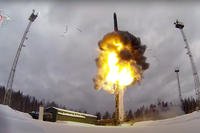Blueprints for a future military are piling up fast in Washington, D.C. It seems like not a week goes by that a new report isn’t released by one think tank or another with the hope of grabbing the attention of defense aides with the incoming Obama administration. While some of these reports are eminently discardable, others actually have some value, if not for their prescriptions, then at least for who wrote the report.
An example of the latter is a new report titled “Building a Military for the 21st Century,” put out by the Center for American Progress, a largely Democratic staffed think tank that is also pulling double duty with the Obama transition team. For that reason alone it might carry more weight than others. So let’s unpack this one.
The report, authored by Larry Korb and others, could be called a “progressive” agenda, as it aims to rein in “out of control” defense spending and calls for cutting the familiar list of “gold plated” weapons systems dreamed up during the Cold War. A lack of fiscal discipline has created an environment where the services are free to spend as much as they want and buy whatever new weapon they fancy, the authors say.
Perhaps the most important ongoing debates in defense policy circles is over the types of wars the U.S. likely to fight in the future. One camp says protracted counterinsurgency campaigns in failed or failing states on the order of Iraq and Afghanistan will dominate. The other says the military must prepare for full scale conventional fights against a regional power, which really means one of three countries: China, Russia or Iran. The answer to that question reveals where an individual or institution is going with force structure recommendations.
The CAP report comes down squarely in the counterinsurgency and irregular warfare camp. While proficiency in conventional fire and maneuver skills cannot be allowed to lapse, this applies to the ground forces of course, preparedness for stability operations should take precedence.
CAP’s solution for bringing defense spending under control is a little fuzzy. They say pulling troops out of Iraq will save $140 billion over the next two years, although $22 billion will need to be redirected to operations in Afghanistan; much of the hoped for savings will come from cutting or slowing development of costly weapons programs.
The report says continue with the planned 92,000 troop end strength increase in the Army and Marine Corps, but don't allow recruitment standards to drop. The authors don’t provide any real good answers on how to solve that problem other than upping financial incentives. They also don’t explain how Defense is supposed to deal with skyrocketing personnel costs, particularly health care. Rising personnel costs will drive up the defense budget, unless force strength is cut. The CAP report's failure to lay out a proposal for dealing with personnel costs is a serious shortcoming.
As for programs: Army reset should be fully funded. The Army’s Future Combat Systems program should be slowed, its budget cut by a third over the next four years and FCS equipment should only outfit 10 brigades instead of the planned 15. The Army should substitute MQ-1C Warrior drones for a new armed reconnaissance helicopter.
Aircraft: End production of the F-22 Raptor at 183 aircraft. Slow development of the F-35 JSF until it’s fully proven in flight tests. Any potential “fighter gap,” real or imagined, should be made up by buying more Block 60 F-16s. Cancel the Marine Corps MV-22 Osprey program, but the Air Force should buy more CV-22s for the special ops community. Build more C-17s at the rate of five a year over the next four years. Build the KC-X. Develop and build a new long range bomber.
Shipbuilding: Cancel the DDG-1000 program and build 2 Arleigh Burke class DDG-51s destroyers a year over the next four years. Continue the plan to build 16 LCSs over the next four years. Keep building Virginia class attacks submarines at the rate of one per year. Build the CVN-78 Ford class carrier, but then delay carrier construction for five years. Cancel the LPD-26 amphib, and while you’re at it, cancel the Marine Corps EFV program, Inchon style amphibious assaults are a thing of the past.
Missile Defense: Cancel unproven systems such as Airborne Laser, Kinetic Energy Interceptor and Multiple Kill Vehicle. Halt deployment of ground based systems, including stop building sties in Poland and the Czech Republic. Continue development of low risk programs such as Aegis and Patriot PAC-3.








